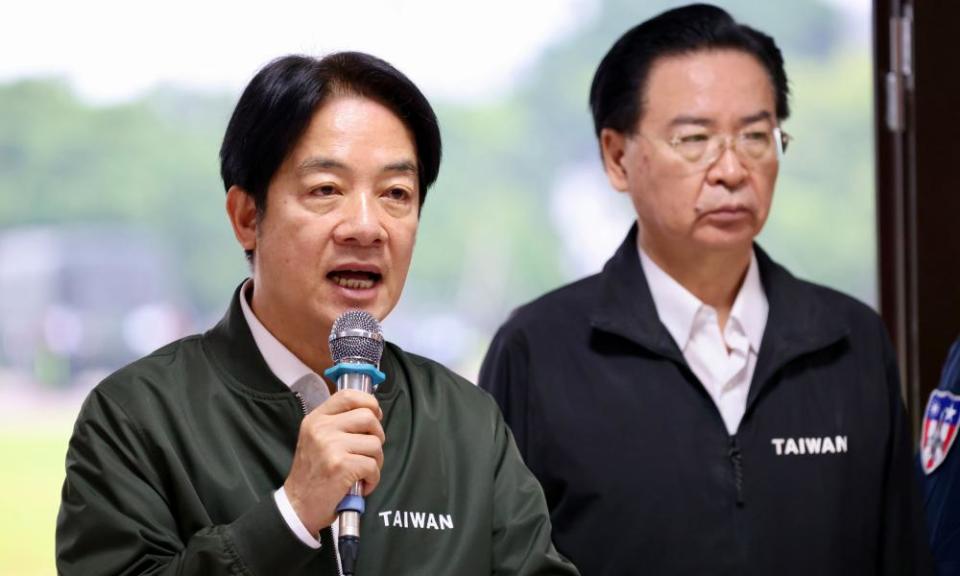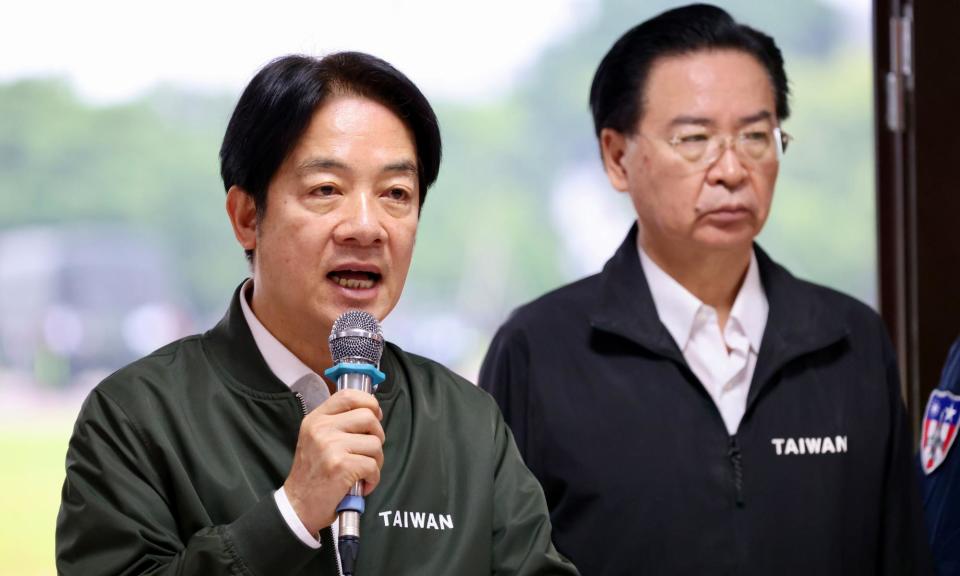How significant are China’s military drills around Taiwan?
China has launched two days of military drills around Taiwan after the island swore in its new president, Lai Ching-te.
Lai takes over from Tsai Ing-wen, Taiwan’s president since 2016. Both are from the Democratic Progressive party (DPP), a pro-sovereignty political party detested by the Chinese government, which views the group as separatists. China claims Taiwan as part of its territory and has vowed to take control of it, with force if necessary.
The naming of this Joint Sword drill, suffixed with -2024A, has fostered expectations there are more drills to come this year.
How significant are the drills?
The drills are the most significant since similar exercises were launched against Taiwan in August 2022 and April 2023. However they appeared smaller in scope, and did not involve live fire near Taiwan on the first day.
Military drills around Taiwan were widely expected this week. After a relatively muted reaction to Lai’s victory in January, analysts were on the lookout for a Chinese show of force in response to the inauguration on 20 May.
The deputy commander of the US Indo-Pacific command, Lt Gen Stephen Sklenka, said the drills were “concerning” but expected. “The normalisation of abnormal actions, that’s what’s happening,” Sklenka said.
Thursday’s exercises included coastguard vessels, which have been used increasingly for enforcement and military-adjacent purposes in recent years. After a fatal collision between an illegal Chinese fishing boat and a Taiwanese coastguard vessel near Kinmen in February, China responded with increased patrols and an explicit rejection of maritime borders which it had until then tacitly respected.
How big are they compared to previous military exercises?
Like the previous war games, Thursday’s also appeared to be practising blockade techniques. Maps of the exercise locations showed Chinese forces targeting five large areas of sea surrounding Taiwan, and several smaller ones around the Taiwanese islands which sit next to the Chinese mainland. The August 2022 drills did not include the small Taiwanese islands as targets.
So far, the drills appear to be smaller and of a lower intensity compared with 2022 and 2023 in terms of level of activity. Taiwan’s defence ministry said China’s People’s Liberation Army (PLA) stayed outside the 24 nautical mile limit of Taiwan’s waters, and only carried out live fire exercises inland, not in the strait or at sea. It did not declare any no-fly zones.
The 2022 drills included the firing of ballistic missiles over Taiwan’s main island into the sea, and analysts believed the 2023 drills showed an increased “war-like” capability, with marked improvement in the launching of fighter jets from aircraft carriers. This year the PLA navy has begun test sailing its third aircraft carrier, an addition to its fleet which analysts say will greatly increase China’s ability to maintain a strong presence across the Taiwan strait, South China Sea and East China Sea.
Why does Beijing dislike Taiwan’s new president?
Beijing said this week’s drills were a “punishment” for “separatist acts” – that is to say, Taiwan voting in Lai as president.
Beijing views the DPP as separatists. It cut off communication with the Taiwanese government in 2016 shortly after Tsai took office. The Chinese government is particularly concerned about Lai, who in the past has advocated more strongly for Taiwanese independence. In recent years, and in his presidential campaign, he softened this stance, and now hews more closely to the path carved out by Tsai of not formally declaring Taiwan’s independence because it already enjoys autonomy in practice.
Nevertheless, Beijing detests Lai and took particular exception to parts of his inauguration speech which appeared to more strongly affirm Taiwan’s separateness from China than Tsai usually did. In a report on Thursday, the Chinese state media broadcaster CCTV said that Lai “will be nailed to the pillar of history”.
Is Beijing planning a war?
China’s leader, Xi Jinping, has made it clear that he sees resolving the “Taiwan question” as part of his legacy. Analysts and western intelligence mention dates as soon as 2027 as a deadline by which the PLA has been instructed to be ready for a conflict.
A PLA Defence University lecturer, Zhang Chi, told state media the northern sites of this week’s drills “sent a warning” to the ruling DPP. Zhang, who was not speaking on behalf of the PLA, said the eastern areas cut off Taiwan’s energy imports, support lines from the US and other allies, and “the escape route for Taiwan independence forces”.
Zhang’s comments were likely aimed at sending a message to international parties that the PLA took these drills very seriously, and to reassure domestic audiences of China’s strength and control.
There is increasing concern that rather than an all-out assault, Beijing will increase its less militaristic “greyzone” activities, which are harder for Taiwan and other interested parties to calculate a response to. These already include increased coastguard patrols around Taiwan’s outlying islands of Kinmen and Matsu, the shifting of flight paths to Taiwan’s side of the median line, and the frequent deployment of weather balloons – which are civilian but can also gather granular microclimate data which can assist in bombardment attacks – into Taiwan’s airspace. All activities that are arguably civilian, legal and difficult to respond to, but which still put pressure on Taiwan.

 Yahoo News
Yahoo News 

